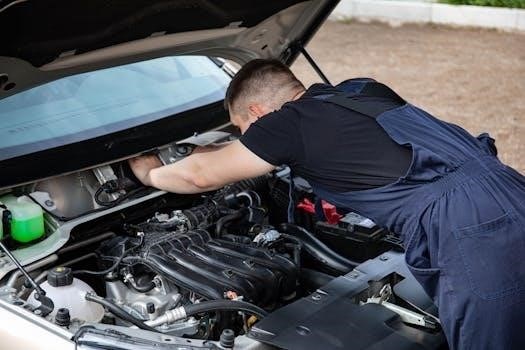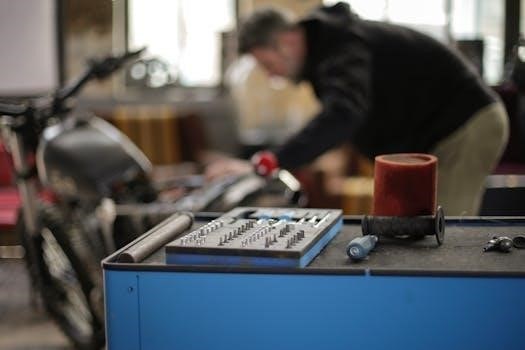
Many enthusiasts seek to enhance their Ford Pinto’s performance by replacing its original engine with a more powerful V8. This swap dramatically increases horsepower and offers a significant performance upgrade. There are manuals available to aid in this process.
The Allure of V8 Power in a Pinto
The appeal of installing a V8 engine into a Ford Pinto stems from the desire to transform a vehicle known for its modest performance into a surprisingly potent machine. The original Pinto engine is often considered underpowered, and swapping to a V8 provides a substantial leap in horsepower, offering a thrilling driving experience. This conversion taps into the potential of the Pinto’s lightweight chassis, creating a unique combination of power and agility. The allure lies in the unexpected nature of this transformation, turning a humble economy car into a performance-oriented vehicle. This is desirable for many who seek a unique, powerful and fun ride.
Understanding the Pinto’s Original Engine
The Ford Pinto originally came with inline-four engines, ranging from 1.6L to 2.3L. These engines offered limited power and durability compared to a V8.
Limitations of the Stock Pinto Engine
The stock Pinto engines, typically ranging from 1.6 to 2.3 liters, are known for their modest power output, often producing around 80 horsepower. These engines lack the performance capabilities that many enthusiasts desire, especially when compared to larger V8 options. The original engines were designed for fuel efficiency and basic transportation, not high performance. Consequently, they are not very durable for those seeking enhanced power or for those who push the vehicle to its limits. Furthermore, the limited aftermarket support for the original Pinto engines makes upgrades challenging, leading many to consider a V8 swap for significant performance improvements and increased durability. The need for improved power and performance is a major factor in this decision.
V8 Engine Options for Pinto Swaps
For Pinto swaps, popular V8 choices include Ford’s 302 and 351W engines. These offer significant power gains over the original inline-four engines. They are also relatively compact and fit well.
Popular V8 Choices⁚ Ford 302 and 351W
The Ford 302 and 351W engines are frequently chosen for Pinto V8 swaps due to their readily available parts and relatively compact size. The 302, also known as the 5.0, is a popular choice for those seeking a balance of power and weight, often sourced from Mustangs and other Ford vehicles. The 351W offers more displacement and thus more potential power, but it can be a slightly tighter fit, requiring careful planning and modifications. Both engines are well-supported in the aftermarket, making them ideal for a swap project. These engines are known for their reliability and performance potential.

Essential Components for the V8 Swap
A successful V8 swap requires specific components such as motor mounts, headers, a modified cooling system, and proper oil pan solutions. These parts ensure compatibility and proper function.
Motor Mounts and Compatibility
Securing a V8 engine into a Pinto requires careful consideration of motor mounts. Often, Mustang II V8 parts are used due to their similar chassis design. Specific brackets and insulators, such as the D6ZZ-6028-A, D6ZZ-6029-B, D7ZZ-6038-A and D7ZZ-6038-B are needed. Fabricating custom mounts is also an option, though pre-made kits can save time and effort. It’s vital to ensure the chosen mounts properly align the engine within the Pinto’s engine bay, allowing for proper drivetrain alignment. The early Pintos may have shorter engine compartments making this task more challenging.
Header Considerations and Options
When performing a V8 swap in a Pinto, header selection is a crucial aspect. Due to space constraints, typical V8 headers won’t fit without modification. Headers designed specifically for V8 Pinto swaps, like those from Hooker and Hedman, are available. These headers often route forward and down to clear the front cross-member. Some may find using 83-84 Mustang GT manifolds a viable option. Custom fabrication is also possible, but requires expertise. Choosing the right headers ensures proper exhaust flow and clearance within the engine bay.
Radiator and Cooling System Modifications
A V8 engine generates significantly more heat than the stock Pinto engine, necessitating cooling system upgrades. Often, the stock radiator is inadequate, and a larger radiator, such as one from an early V8 Mustang, is recommended. This often requires moving the radiator forward and spacing the grille for improved clearance. A water pump kit from a V8 Explorer may simplify the process. An electric cooling fan may also be required to provide adequate airflow due to space limitations. Careful planning of hose routing is also critical.
Oil Pan and Filter Considerations
When swapping a V8 into a Pinto, the oil pan and filter location become crucial. The original Pinto’s oil pan might not clear the V8’s components, necessitating a front sump pan, common in Ford passenger cars of that era. The oil filter’s position on the driver’s side can interfere with steering gear, requiring relocation on some models, sometimes towards the passenger side as is common in V8 swaps. A shorter filter might help, but a relocation kit could be needed. Careful planning is essential for a successful swap.

Transmission and Drivetrain
A crucial aspect of a V8 swap involves selecting a transmission that can handle the increased power. Matching the transmission to the V8 engine is essential for reliable performance and durability.
Matching the Transmission to the V8
Selecting the correct transmission for your V8 Pinto swap is crucial for ensuring optimal performance and longevity. The original Pinto transmission will not withstand the power of a V8 engine. A common choice is a Ford C4 or AOD automatic transmission or a manual transmission from a Mustang or similar vehicle. Careful consideration of the transmission’s gear ratios and torque capacity is essential. It should be able to handle the increased horsepower and torque output of the new engine. Adapting the transmission to the Pinto chassis might require custom fabrication or specific aftermarket parts.
Body and Chassis Modifications
Integrating a V8 engine into a Pinto often necessitates modifications to the body and chassis. These adjustments may include reinforcing the chassis and addressing engine bay space constraints.
Addressing Engine Bay Space Constraints
The Pinto’s engine bay was originally designed for a smaller four-cylinder engine, so fitting a V8 requires careful planning and modifications. The physical size of a V8 engine often necessitates adjustments to the radiator, which may need to be moved forward or a smaller unit used. The engine’s width can also be a challenge, requiring careful placement and potentially custom headers that route forward and down around the front cross member. Additionally, some Pinto owners space out the grill to make things fit better. Early models are known to have shorter engine compartments than later models, which further complicates the process.
The Complete V8 Pinto Engine Swap Manual
Randy Young, from Texas, has a home-published manual which can assist with the V8 swap process. This manual is a resource for owners undertaking the swap.
Randy Young’s Home-Published Manual
Randy Young’s manual is a key resource for individuals contemplating a V8 engine swap into their Ford Pinto. This home-published guide offers detailed instructions, addressing the specific challenges of this conversion. It outlines the necessary steps, from engine removal to final installation. The manual covers critical aspects like motor mount fabrication and header selection, providing practical solutions for common issues encountered during the swap. It may also feature solutions for radiator relocation and cooling system modifications. This resource is invaluable for achieving a successful V8 swap, especially for those lacking prior experience.

Performance Benefits of a V8 Swap
A V8 swap drastically increases the Pinto’s horsepower, potentially from 80 to 210-500. This leads to significant gains in acceleration and overall performance, transforming the car’s driving experience.
Horsepower Increase and Performance Gains
The most significant advantage of a V8 swap in a Ford Pinto is the substantial increase in horsepower. The original Pinto engines, whether inline-four or V6, offered relatively modest power outputs, typically around 80 horsepower. By replacing it with a V8, such as a Ford 302 or 351W, enthusiasts can achieve a dramatic leap in power, often ranging from 210 to 500 horsepower depending on the specific engine and tuning. This translates to a massive improvement in acceleration, top speed, and overall driving performance. The transformation from a modest economy car to a potent muscle car is a key reason why many undertake this swap, seeking enhanced power and a more thrilling driving experience.

Challenges and Considerations
Swapping a V8 into a Pinto presents challenges. Issues like engine bay space, proper fitment, and the need for custom parts can arise. Solutions must be found for these complications.
Potential Complications and Solutions
Performing a V8 swap in a Pinto can introduce several potential complications. The original Pinto engine bay is not designed for a V8, leading to space constraints. Header fitment often requires aftermarket solutions, sometimes necessitating forward-exiting designs due to limited space. Radiator placement may need adjustments, possibly involving moving it forward or using a smaller unit. Oil pan clearance can also pose an issue, often requiring the use of a front-sump pan. Solutions might include custom fabrication, utilizing specific Mustang II parts, or relocating components. Careful planning and research are essential to overcome these challenges effectively, ensuring a successful swap;
Additional Notes
Early Pinto models feature shorter engine bays compared to later versions, potentially affecting component fitment during a V8 swap. This difference may require unique modifications for successful installations.
Differences Between Early and Later Pinto Models
The early Ford Pinto models, specifically those produced before 1974, have shorter engine compartments when compared to the later models. This difference in engine bay length can significantly impact the installation of a V8 engine. The later models, mirroring changes introduced in the Mustang II, offer slightly more space, potentially simplifying certain aspects of the swap. Consequently, parts or kits designed for one generation may not directly fit the other, requiring careful consideration and adjustments during the engine swap process. Furthermore, the overall chassis design saw some changes between these generations, which should be taken into account.